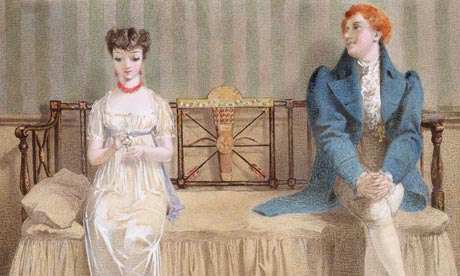
What do men want from a wife? Well, in the 17th century, based on the evidence in what Francesca Beauman claims is the world's first lonely hearts ad, the answer is: hard cash. "A Gentleman about 30 Years of Age, that says he had a Very Good Estate, would willingly Match himself to some Good Young Gentlewoman that has a Fortune of 3000l. or thereabouts, and he will make Settlement to Content."
That's about £300,000 in today's money, and although Beauman raises the possibility that John Houghton, the publisher of the pamphlet in which this appeared (the prosaically titled A Collection for Improvement to Husbandry and Trade), may simply have made it up, for the next 100 years, the period in which matrimonial advertisements first flourished and multiplied, the list of desires and requests was dominated by financial rather than romantic considerations. Even by the standards of the day, however, this one from 1759 was extreme: "A young man wants a wife with two or three hundred pounds; or the money will do without the wife." (Even more amazing is that this actually worked: he got the money.)
What Beauman notes is that the rise of the lonely hearts ad went hand in hand with the rise of the novel. It was, she says, "an entirely new form of text". And it differed "from conventional forms of textual courtship, such as love poetry, in that it tended to be the man's virtues that were the focus, rather than the woman's". Emerging just as Daniel Defoe published Robinson Crusoe (1719), Samuel Richardson Pamela (1740) and Henry Fielding Joseph Andrews (1742), lonely hearts ads offered, she says, "a new paradigm for fiction". Both shared "a new-found focus on the individual" and enabled the reader "to peer into their private lives to find out what it is they want, need, crave".
Perhaps what's most surprising about these early ads is how little importance is placed on the physical. A "good physiognomy" or "pleasing figure" is about as far as the advertisers go (although one requests that the woman should be "of no bodily deformity"). The "shapely ankle preferr'd" of the title, from a 1770 advert, is, Beauman says, positively "risqué". By the end of the 1700s, romantic love had begun to replace commercial considerations (though not entirely: the Reading Mercury of 1798 records that, "To avoid extra expenses, Mr Surrell would wish to keep his wedding and harvest-home the same evening, which will be within fourteen days from the present date"). And women had begun to advertise, many with "pathetically low expectations about the sort of man they might hope to attract", although one from 1787 prints her list of requirements, beginning with, "He must never drink above two bottles of claret or one of port, at a sitting, and that but three times a week."
In fact, Beauman devotes almost half of this (not very long) book to the emergence of the genre in the 18th century, and this is where she's at her strongest, although there are a couple of interesting forays into the 19th century, particularly the tale of one William Corder who, after brutally murdering one woman, found a new one through a matrimonial newspaper.
What this book isn't, as the subtitle claims, is "A History of the Lonely Hearts Ad 1695-2010". The 20th century is skipped over in a few pages; much of the information, Beauman acknowledges in the footnotes, comes from the research of HG Cocks, who explored the material in far more detail in his 2009 Classified: The Secret History of the Personal Column. He charted the rise of gay personal ads – Beauman offers a synopsis here – in which young men described themselves as "theatrical" or "unconventional", leading to the 1921 trial of the publisher Alfred Barrett, who was charged with conspiring to corrupt public morals "by introducing men to men for unnatural and grossly indecent practices".
On the subject of internet dating, all Beauman has to offer is: "Almost all my single friends are currently engaged at some level or another in internet dating, and rarely does a Sunday brunch go by without being regaled with tales of the latest disastrous date." That's it? Really?
Lots of original and interesting research has gone into this book; Beauman has scoured the newspaper archives, and selected quirky and interesting snippets, mostly from the 18th century. But apart from her literary observations of this period, the narrative is patched together with glib evolutionary theory ("These ads encapsulate a central tenet of human mate choice: men want a partner who is young"), glib ethnography (the Na people of China are the only "human society that has not made marriage in one form or another central to the way it is organised") or glibber historical ones. There's no thesis, no methodology, and although it's "social history" written for a mainstream audience, it seems confused about what its intentions are, and what it wants to prove. Worst of all is the ending, in which Beauman chooses to riff freely on the subject of marriage. More specifically, "our" generation's "continuing enthusiasm for marriage" exposes, she claims, "the powerful streak of optimism that resides within many of us". Maybe, but is that what this book's about? If so, I missed it.
To buy a copy for £xx.xx with free UK p&p call 0330 333 6847 or go to guardianbookshops.co.uk

